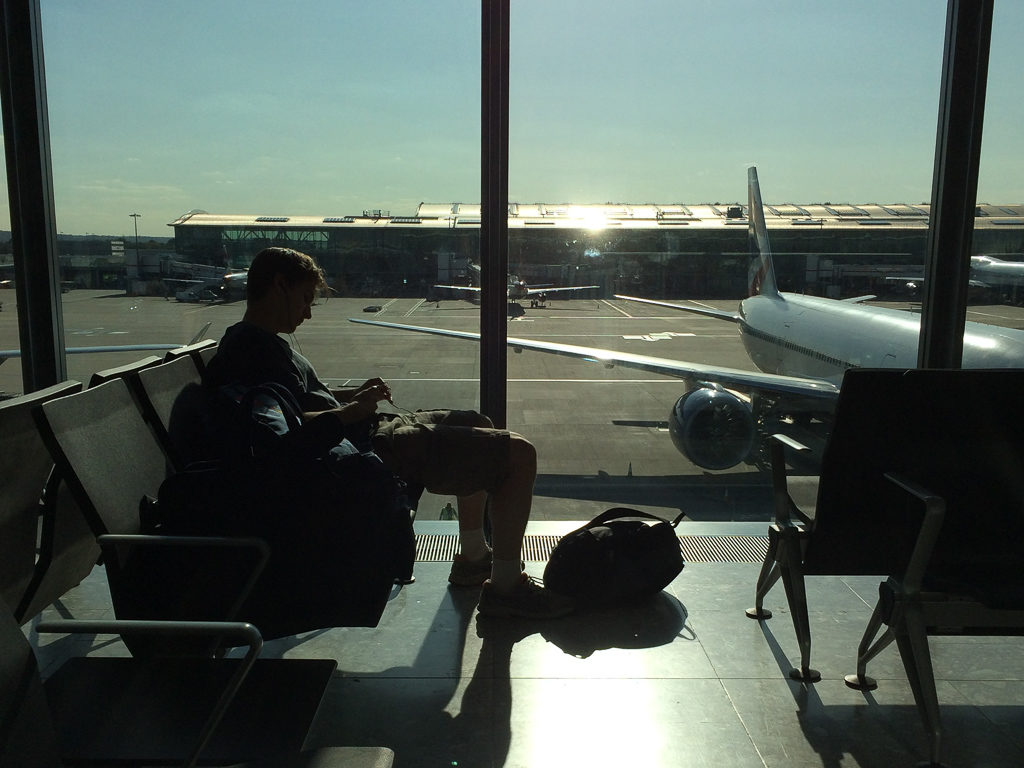In households all over the country teens are planning a post-exam summer of travel around Europe by train. But are they properly prepared for weeks on the road? Here’s our tried and tested interrail packing list, including best backpacks for interrailing, clothes to pack and essential accessories. Don’t let them leave home without it! UPDATED 2023

This post contains affiliate links, this means that I may receive a commission at no cost to you if you click a link and make a purchase.
I’ll confess straight away that I love a packing list. I’ve kept them for all our family trips and made a note of what we did and didn’t need. (I know). They’re useful to refer to on future trips – and in the same way we refined an interrail packing list over the years.
Writing an interrail packing list
When each of my sons went off on his first interrail travels I made a list of what he took – and then checked again after the trip to see what was and wasn’t essential. The boys were already used to packing rucksacks for camping expeditions and backpacks for holidays. Plus they got extra tips from friends who’d already been interrailing.
It’s a few years now since those first interrail forays and the boys have done many more backpacking trips. So I’ve tapped into their expertise to update our essential packing list for interrailing.
I’m a mum of boys so our interrail packing list is necessarily a male-orientated one. But you’ll find travel essentials and packing tips here that work for everyone, parents included.
What is interrailing?
The European interrail trip is a post-exam tradition for British teens. For many it is their first proper holiday without their parents in tow. In brief, they buy an Interrail pass, valid for 15 days, 22 days or a month, and plot their journey by train around European cities. They’ll sleep in hostels, Airbnbs or sometimes on the trains themselves. Currently eastern Europe is particularly popular with student interrailers as the cost of living is lower than in western European cities like Paris or Berlin. You can read more of our interrail tips for teens, here.

Pin this to Pinterest to save and share
Best Backpacks for Interrailing
Interrailing is by nature an urban adventure. It isn’t an expedition-style holiday unless you deliberately make it so. Most interrailers travel from city to city by train and then stay in hostels or Airbnbs. Lots catch planes to their first destination as it works out cheaper than using the Eurotunnel. Occasionally they’ll overnight on a train.
But generally speaking, unless they’re actually camping, they don’t need sleeping bags. And unless they get lost they don’t spend a great deal of time walking with all their belongings on their backs. So interrailing in Europe is different to more exotic gap year adventures and the luggage required is a bit different too.
Holdall vs suitcase vs backpack for interrailing
The type of bag you pick is very much down to personal preference. My boys both chose to use convertible holdalls, also called duffel bags, for their interrailing trips. These can be carried on both shoulders like a backpack, slung from one shoulder or carried by short grab handles. The boys were both happy with their choices because their bags were easy to manoeuvre and pretty compact.
A holdall might be less suitable if you’re planning more independent travel with a likelihood of walking greater distances with pack on back. For that kind of trip a conventional rucksack or a lightweight backpack with a frame might be better.
Pros of a convertible holdall
- They have full length zipped flaps for access so they can be packed like a suitcase. Unlike a rucksack, you can see the full contents of the bag without having to unpack it all first.
- They’re lighter in weight than a toploader rucksack with a rigid frame. And a holdall is more manoeuvrable too.
- It is flexible enough to be shoved into overhead luggage racks on the train. Plus you can sling it on and off your shoulders quickly making it easy to carry through crowds and train carriages.
- On top of this, there’s a sporting chance that your clothes come out in reasonable shape as long as you folded them and packed the bag snugly.
- A holdall can usefully double up as holiday luggage and sports bag too.
Cons of a convertible holdall
- Unlike a proper rucksack a duffel don’t hug the body or distribute the weight. They hang from the shoulders rather than letting your hips take some of the strain.
- Nor do they have the technology that helps to stop your back overheating. However neither of my boys had to walk far with their bags when they were interrailing so they didn’t find this a problem.
- Some of the boys’ friends have pointed out that a fully loaded duffel is a lot of weight on the shoulders. This can make a flight of stairs or a long station platform a bit of a challenge. In this case the best alternatives are a wheeled suitcase or lightweight backpack.
Can you take a suitcase interrailing?
A wheeled suitcase or backpack for interrailing would make light work of a heavy bag. However wheelie bags still have to be carried on cobbled streets or flights of stairs and the wheel system adds weight. And my sons point out that it’s more convenient to move around ‘hands free’ with your travel bag on your back when you’re navigating with a phone and map.
Interrailing with a rucksack
One or two of my sons’ friends took a rucksack interrailing. I’m using the term ‘rucksack’ here to mean the big, rugged top-loading backpacks that are used on camping expeditions such as in the Duke of Edinburgh (DofE) scheme.
The key is to make sure that the bag fits you well at the outset. By distributing the weight of the bag between the shoulder and hip straps, a good rucksack makes your load feel much more manageable. An outdoor activity shop will be able to help you to choose and fit a rucksack correctly.
The disadvantage of a big expedition rucksack is that the frame adds weight and it can be bulky to manoeuvre on a train. On top of this the top-loading style can mean you have to unpack the whole thing to get to items at the bottom. But packing cubes can really help here, see below.
Interrailing with a backpack
I’m using ‘backpack’ here to define lighter weight backpacks that help to bridge the gap between a big expedition rucksack and a suitcase. Some have a zipped panel openings for suitcase-style access and others even come with wheels. They’re lighter than a traditional rucksack but distribute the weight better than a duffel bag or holdall.
Choosing the best backpack for interrailing
If you decide to choose a holdall or duffel bag the ones we’ve used have been strong and comparatively inexpensive. Nick uses a Patagonia unisex duffel bag.
It’s made of ripstop polyester with a laminate water-repellent finish and has shoulder straps to convert it to a backpack. These Patagonias come in a range of sizes and colour combos. Ours is bright blue and grey and very easy to spot on an airport carousel (or to keep an eye on in a luggage rack). It’s 55 litre and weighs 1.1kg. Nick preferred a 55 litre size for inter-railing. The larger 70 litre bag may hold more but it can become very heavy to carry around.
Nick’s Patagonia bag is now several years old. It survived university as well as inter-railing, and there’s no real sign of wear or tear. It’s been a very good buy.
Click here to view and buy a 55 litre Patagonia duffel for your inter-railing trip.
Best backpack for interrailing
If you decide to choose a backpack for interrailing then the Osprey Farpoint comes well recommended. Ospreys are famously good quality: plus it’s actually two packs in one giving you a useful day bag too.
- The Osprey Farpoint is a lightweight backpack with hipbelt and frame but – and this is a real bonus – it has a large zipped panel to access the main 55 litre compartment. This means it packs like a suitcase and is lockable too.
- The ventilated back panel and Light Wire frame suspension is well-designed to achieve a comfortable fit with adjustable straps on torso and hips.
- Cushioned grab handles on the top and sides make it easy to carry and lift onto luggage racks.
- It comes with a handy detachable 15 litre day pack that has top and side pockets and a laptop sleeve. This can also be clipped, kangaroo pouch style, to the front of the harness so that you can keep an eye on your valuables.
The Osprey Farpoint comes in a choice of 40, 55 or 70 litre capacity. The 70 litre weighs 2.5kg. The Osprey Fairview has the same features as the Farpoint but with a women-specific fit. The 40 litre model is carry on size, and it’s also available in 55 or 70 litres with detachable day packs.
I also like the look of this sturdy wheeled backpack the unisex Osprey Rolling Transporter 60 at 2.88kg.
PLANNING AN INTERRAIL OR EURAIL TRIP? Then check out our top interrailing tips for teenagers planning a summer trip to Europe without parents, here
Putting together an interrail packing list
Here’s our own packing list for interrailing, refined over several years of trips around Europe.
Documents for interrailing
Passport, tickets, flight info, travel insurance details, rail tickets, seat reservations, train times: In the past we’ve packed important documents together in a ziplock bag. It keeps things dry and safe from rain, damp towels or leaky suncream. Even though some tickets are served online these days it’s still a good idea to keep paper copies of information.
But these multi-purpose travel wallets are next level! With storage for passport, cards, docs and tickets, they have RFID protection too. Available in black or choose from lots of bright colours that’ll be easy to spot when rummaging around in an over-stuffed backpack.
Or a travel money belt has the dual purpose of keeping passport and docs in one place and being wearable too.
Some currency and bank card. The boys hate carrying change but a few euro notes are always useful to have around. For the rest Ed tucks his bank card into his phone case – double jeopardy if it’s lost or stolen of course. It’s worth researching the best card to take too. MoneySavingExpert has tips on finding the right debit card or credit card for international travel to help avoid transaction fees, cash withdrawal fees or interest charges overseas.
Tech for an interrailing trip
Adaptor plugs for chargers. Do you need a 3 pin travel plug adaptor? Check also that your adaptor is compatible for all the European countries you need. Some don’t work in Italy for example. This European plug adaptor is built to UK safety standards, has 3 USB ports and supports high powered devices like hairdryers.
Phone and charger cables. Make sure you’ve got the right connecting cables and ideally stash them all together in their own bag.
Waterproof bag for phone. They’re very handy on the beach or in a kayak to protect a phone from sand and splashing. I use one for keys, currency and lipbalm on the beach too.
This Waterproof Pouch bag and phone case looks great for beach trips.
Power bank for extra phone charging. An essential piece of kit for all travellers. Keep a portable battery pack charged up and it’ll come into its own on the train or at a festival. This Anker Power Bank is a small and lightweight portable charger.
Portable Bluetooth speaker Ed and friends always take a bluetooth speaker. It’s handy for music wherever they’re staying and Ed’s has survived unscathed to go on multiple trips. This Sony wireless portable compact bluetooth speaker has great reviews and is waterproof and dustproof which sounds an excellent idea. Different colours to choose from too and comes with a detachable carrying strap.
Travel accessories for interrailing
Belt pouch. Light, stretchy belt pouches are useful extra ‘pockets’ on trips when you want to conceal money, bank cards or a phone under whatever you’re wearing.
Flexible refillable water bottle. Our platypus water bottle is the 500ml size so not at all bulky when full. Platypus give exhaustive instructions for cleaning involving bicarb of soda or lemon juice, if hot soapy water isn’t enough.
Sunglasses European sun can be dazzling and you don’t want to rely on a dodgy pair from a souvenir shop. Can’t go wrong with Raybans.
Travel pillow. A comfy little 100% cotton flannel travel pillow and slip won’t take up much space. It has its own drawstring bag to squish it down neatly to pack. Very welcome when you’re desperate for some shuteye on long train journeys. Ours has been on several trips and also in and out of the washing machine.
Sleeping bag liner. Useful in the case of doubtful hotel or hostel cleanliness. A sleeping bag liner is also handy in places that only provide a duvet even in the height of summer.
Travel towel. A ‘proper towel’ takes up ridiculous amounts of room in a backpack and never dries out once wet. And then it becomes smelly. These quick drying microfibre travel towels have a handy press stud fastening so can be easily hung up on a branch or parasol. Since Airbnbs often provide towels this might be all you’ll need.
If the trip is going to include beaches then a lightweight, compact, quick-dry and sand- free microfibre towel would be a great option. These Dock & Bay towels were featured on BBC’s Dragon’s Den. Lots of stripy colours to choose from too.
Packing cubes. Not something my boys have used! But a friend of Ed’s says they make a big difference to packing in a rucksack. Pack all the t-shirts together in cubes like these and they’ll be easy to spot and a lot less crumpled too. Get really organised and have a cube for each category of clothing.
Carbon monoxide alarm. A faulty gas appliance in rented accommodation can leak deadly carbon monoxide. It is odourless and tasteless. We use detectors in our own homes so why do we assume that holiday stays are automatically safe? And I can’t say I’ve found detectors in many Airbnbs in Europe. Project Shout promotes awareness. We carry a Kidde on trips.
Travel Washbags
Washbag A hanging toiletry bag is a good idea for travelling.
This Osprey Europe Ultralight Zip Washbag is well made and gets great reviews. It would make a good gift too.
Pharmacy essentials for Interrailing
Toothbrush, toothpaste, shower gel or body wash, shampoo, deodorant, shaving gel, razor, hair gel, comb etc. These are the essential items but your teens will know what they want to take.
We do a trolley dash round Boots or Superdrug for travel sizes. They aren’t cheap and I’d prefer a more sustainable solution but I find those empty refillable travel size bottles are fiddly to use and tricky to clean once you get home.
Don’t forget packs of wet wipes and anti-bacterial hand wipes which interrailers will thank you for on an overnight train. A tube of travel wash for hand laundry wouldn’t go amiss either. And a ziplock bag containing a wodge of loo paper will pack easily and might be very welcome one day.
Medical kit for interrailing
Check you’ve packed any prescription requirements plus paracetamol and antihistamines if necessary. A mini first aid kit of antiseptic wipes and a few plasters will probably come in handy. Plus blister plasters. Compeed are great.
Insect repellent spray and insect bite cream are a very good idea too. The strength of the repellent depends on the itinerary. Pyramid Trek sensitive insect repellent is a no-DEET formula that is well thought of. But sometimes only Jungle Formula will do. The Jungle Formula Medium Non Tropics range is designed for short haul destinations with just 20% DEET.
An insect bite cream will be welcome when the inevitable happens. We’ve found After Bite is quite effective.
Sun cream. Since the backpack will be too big to carry on to a flight and will have to go in the hold I encourage the boys to take a big bottle of suncream plus a travel size. We like the Nivea ones. Or Ambre Solaire UV Sport SPF 30 comes in a 50 ml travel size.
The bigger bottle can be applied in the mornings then left in the backpack. The pocket size can go out for the day with them. Well, I can but dream!
If you buy any new products especially for the trip I’d recommend trying everything at home first. From suncreams to insect repellents and bite creams, it’s worth checking in advance for any sensitivities or allergies.
Clothing essentials for an interrail trip
This’ll be a personal choice and again the following is a boy’s list. This is what Ed took on a three week interrail trip in very mixed European weather. It allows for ‘going out’ clothes for evenings too.
- 7 x t-shirts. Ed wore and washed them all. It’s helpful when an Airbnb has a washing machine.
- 5 x shorts inc 2 pairs of cargo shorts and 2 of sport shorts. Ed’s top tip is to take shorts with zip pockets – handy for a card or a phone.
- 1 thin jumper
- 1 shirt
- A pair of jeans
- 2 x swim trunks
- 6 pairs socks and pants
- Flip flops or slides – for hostel showers as well as the beach
- Trainers
- A pair of smarter shoes for going out
- Cap
- Waterproof jacket. Ed had torrential downpours as well as 40 degree sun on his interrail trip. A lightweight packaway rain jacket avoids the problem of how to dry clothes that are dripping wet.
- Add an empty plastic bag to keep dirty kit separate from clean clothes.
Entertainment
We’ve already covered music in the tech section. But for those loooonng train journeys Ed recommends:
A book. Controversial but when there’s no wifi sometimes old fashioned is best.
A pack of cards.
How to pack for interrailing
I’d strongly recommend starting to pack at least a week, ideally two, before departure day. It’s useful to get together all the clothes and bits and pieces on your interrail packing list. Then work out how they’re all going to fit in the bag. This is a good time to think of using packing cubes too. And to double check your list to ensure nothing has been forgotten.
Once the bag is packed it’s a good idea to put it on and go for a walk round the block. This will help to make sure that it’s adjusted correctly and it isn’t going to rub, pinch or be far too heavy. Check too that it’s light enough to be lifted onto an overhead luggage rack.
It’s also a good plan to work out where tickets, money, phone, sunglasses and water are going to be stowed, both in transit and on a day out.
Please note that all information here is for guidance only. Please check the relevant websites for the most up to date information eg. prices, product features etc.
As an Amazon Associate I earn from qualifying purchases.
Interrailing Essentials

Like this post? Please pin this to save and share to Pinterest!

About the author Nancy Roberts is a former women’s magazine editor and writer. She lives in London and is mum to two 20-something boys. In Map&Family she shares info and inspiration for curious travellers: singles and couples as well as families travelling with teens and young adults.
All photos are all rights reserved. Please do not reproduce these photos without prior written permission




Leave a Reply